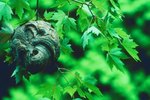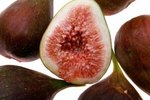
Wasps are beneficial insects that help control pest populations. Insects are fed to wasp larvae from spring until fall, when carbohydrates such as fruit and flower nectars are fed, ensuring extra plumpness for the new queens' winter hibernation. Identified by her size and the time of year, the queen isn't seen from late spring through summer. She remains in her nest, laying eggs and being fed and cared for by her female workers.
She's the Largest in the Colony
Wasps are narrow-waisted with pointy abdomens. They can be brown, metallic blue, red or yellow. The queen wasp is much larger than the female workers and the males, called drones. She's the largest wasp in the colony, and her life's purpose is to lay eggs. Only female wasps, including queens, have stingers, which are used solely for self-defense. Bright colors warn others of their painful sting.
A New Colony Begins in Spring
The new queen, previously fertilized, emerges from hibernation in late spring. She makes a small nest to begin her new colony. The first eggs laid are sterile female workers, hatching in three or four weeks. From early spring until the end of May, when new workers take over foraging and care of the queen, any solitary wasp you see is probably a queen. She must forage to feed her first worker larvae.
Mating Occurs in Autumn
Throughout the summer, the queen produces worker wasps, continually enlarging the colony. In late summer, the last eggs to hatch will be new queens and drones. Identified by their size, the virgin queen wasps fly around meadow flowers, eating and fattening up, until flying off to mate with drones from other hives in the fall. After mating, the drones will die with the old queen and her colony of workers when winter's cold temperatures arrive.
Only Queens Live Through the Winter
Any live wasp you see during winter is a queen. Only new queens survive though the winter. Queen wasps hibernate in areas protected from freezing temperatures, but not warm enough to prevent dormancy. They're found under tree bark or in the cracks and crevices of eaves and wood trim, with their wings wrapped around their bodies. Use caution; even during dormancy the queen wasp can sting.
References
Photo Credits
-
John Foxx/Stockbyte/Getty Images
Writer Bio
Karen Mihaylo has been a writer since 2009. She has been a professional dog groomer since 1982 and is certified in canine massage therapy. Mihaylo holds an associate degree in human services from Delaware Technical and Community College.




